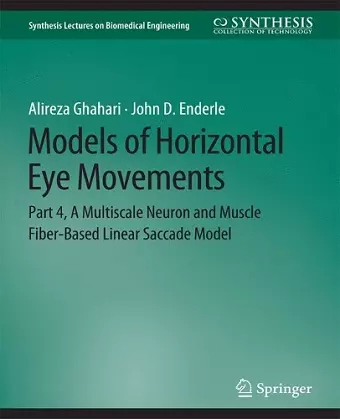Models of Horizontal Eye Movements
Part 4, A Multiscale Neuron and Muscle Fiber-Based Linear Saccade Model
Alireza Ghahari author John D Enderle author
Format:Paperback
Publisher:Springer International Publishing AG
Published:13th Mar '15
Currently unavailable, and unfortunately no date known when it will be back

There are five different types of eye movements: saccades, smooth pursuit, vestibular ocular eye movements, optokinetic eye movements, and vergence eye movements. The purpose of this book series is focused primarily on mathematical models of the horizontal saccadic eye movement system and the smooth pursuit system, rather than on how visual information is processed. In Part 1, early models of saccades and smooth pursuit are presented. A number of oculomotor plant models are described here beginning with the Westheimer model published in 1954, and up through our 1995 model involving a 4th order oculomotor plant model. In Part 2, a 2009 version of a state-of-the-art model is presented for horizontal saccades that is 3rd-order and linear, and controlled by a physiologically based time-optimal neural network. Part 3 describes a model of the saccade system, focusing on the neural network. It presents a neural network model of biophysical neurons in the midbrain for controlling oculomotor muscles during horizontal human saccades. In this book, a multiscale model of the saccade system is presented, focusing on a multiscale neural network and muscle fiber model. Chapter 1 presents a comprehensive model for the control of horizontal saccades using a muscle fiber model for the lateral and medial rectus muscles. The importance of this model is that each muscle fiber has a separate neural input. This model is robust and accounts for the neural activity for both large and small saccades. The muscle fiber model consists of serial sequences of muscle fibers in parallel with other serial sequences of muscle fibers. Each muscle fiber is described by a parallel combination of a linear length tension element, viscous element, and active-state tension generator. Chapter 2 presents a biophysically realistic neural network model in the midbrain to drive a muscle fiber oculomotor plant during horizontal monkey saccades. Neural circuitry, including omnipause neuron, premotor excitatory andinhibitory burst neurons, long lead burst neuron, tonic neuron, interneuron, abducens nucleus, and oculomotor nucleus, is developed to examine saccade dynamics. The time-optimal control mechanism demonstrates how the neural commands are encoded in the downstream saccadic pathway by realization of agonist and antagonist controller models. Consequently, each agonist muscle fiber is stimulated by an agonist neuron, while an antagonist muscle fiber is unstimulated by a pause and step...
ISBN: 9783031005350
Dimensions: unknown
Weight: unknown
108 pages